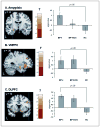Differential patterns of abnormal activity and connectivity in the amygdala-prefrontal circuitry in bipolar-I and bipolar-NOS youth
- PMID: 22115148
- PMCID: PMC3268077
- DOI: 10.1016/j.jaac.2011.09.023
Differential patterns of abnormal activity and connectivity in the amygdala-prefrontal circuitry in bipolar-I and bipolar-NOS youth
Abstract
Objective: The functioning of neural systems supporting emotion processing and regulation in youth with bipolar disorder not otherwise specified (BP-NOS) remains poorly understood. We sought to examine patterns of activity and connectivity in youth with BP-NOS relative to youth with bipolar disorder type I (BP-I) and healthy controls (HC).
Method: Participants (18 BP-I youth, 16 BP-NOS youth, and 18 HC) underwent functional magnetic resonance imaging while performing two emotional-face gender labeling tasks (happy/neutral, fearful/neutral). Analyses focused on a priori neural regions supporting emotion processing (amygdala) and emotion regulation (ventromedial prefrontal cortex (VMPFC), dorsolateral prefrontal cortex (DLPFC). Connectivity analyses used VMPFC as a seed region.
Results: During the happy-face task, BP-I youth had greater amygdala, VMPFC, and DLPFC activity to happy faces whereas BP-NOS youth had reduced VMPFC and DLPFC activity to neutral faces relative to HC, and reduced amygdala, VMPFC, and DLPFC activity to neutral faces versus BP-I. During the fearful-face task, BP-I youth had reduced DLPFC activity to fearful faces whereas BP-NOS youth had reduced DLPFC activity to neutral faces relative to HC. BP-NOS youth showed greater VMPFC-DLPFC connectivity to happy faces relative to HC and BP-I youth. BP-I youth showed reduced VMPFC-amygdala connectivity to fearful faces relative to HC and BP-NOS youth.
Conclusions: This is the first study to document differential patterns of abnormal neural activity in, and connectivity between, neural regions supporting emotion processing and regulation in BP-NOS versus BP-I youth. Findings suggest that despite similarities in symptom presentation, there are differential patterns of abnormal neural functioning in BP-NOS and BP-I relative to HC, which might reflect an "intermediate state" in the course of BP-I illness. Future longitudinal studies are needed to relate these findings with future conversion to BP-I/II.
Copyright © 2011 American Academy of Child and Adolescent Psychiatry. Published by Elsevier Inc. All rights reserved.
Figures



Similar articles
-
Elevated striatal and decreased dorsolateral prefrontal cortical activity in response to emotional stimuli in euthymic bipolar disorder: no associations with psychotropic medication load.Bipolar Disord. 2008 Dec;10(8):916-27. doi: 10.1111/j.1399-5618.2008.00641.x. Bipolar Disord. 2008. PMID: 19594507 Free PMC article.
-
Altered amygdala-prefrontal response to facial emotion in offspring of parents with bipolar disorder.Brain. 2015 Sep;138(Pt 9):2777-90. doi: 10.1093/brain/awv176. Epub 2015 Jun 24. Brain. 2015. PMID: 26112339 Free PMC article.
-
Amygdala activity and prefrontal cortex-amygdala effective connectivity to emerging emotional faces distinguish remitted and depressed mood states in bipolar disorder.Bipolar Disord. 2012 Mar;14(2):162-74. doi: 10.1111/j.1399-5618.2012.00999.x. Bipolar Disord. 2012. PMID: 22420592 Free PMC article.
-
Rethinking the Use of Neutral Faces as a Baseline in fMRI Neuroimaging Studies of Axis-I Psychiatric Disorders.J Neuroimaging. 2017 May;27(3):281-291. doi: 10.1111/jon.12403. Epub 2016 Nov 2. J Neuroimaging. 2017. PMID: 27805291 Review.
-
Course of subthreshold bipolar disorder in youth: diagnostic progression from bipolar disorder not otherwise specified.J Am Acad Child Adolesc Psychiatry. 2011 Oct;50(10):1001-16.e3. doi: 10.1016/j.jaac.2011.07.005. Epub 2011 Sep 8. J Am Acad Child Adolesc Psychiatry. 2011. PMID: 21961775 Free PMC article. Review.
Cited by
-
Affective network and default mode network in depressive adolescents with disruptive behaviors.Neuropsychiatr Dis Treat. 2015 Dec 31;12:49-56. doi: 10.2147/NDT.S95541. eCollection 2016. Neuropsychiatr Dis Treat. 2015. PMID: 26770059 Free PMC article.
-
Distinguishing bipolar disorder from other psychiatric disorders in children.Curr Psychiatry Rep. 2014 Dec;16(12):516. doi: 10.1007/s11920-014-0516-2. Curr Psychiatry Rep. 2014. PMID: 25315116 Review.
-
Emotional regulation neural circuitry abnormalities in adult bipolar disorder: dissociating effects of long-term depression history from relationships with present symptoms.Transl Psychiatry. 2020 Nov 2;10(1):374. doi: 10.1038/s41398-020-01048-1. Transl Psychiatry. 2020. PMID: 33139703 Free PMC article.
-
Structural brain abnormalities and suicidal behavior in borderline personality disorder.J Psychiatr Res. 2012 Apr;46(4):516-25. doi: 10.1016/j.jpsychires.2012.01.003. Epub 2012 Feb 14. J Psychiatr Res. 2012. PMID: 22336640 Free PMC article.
-
Neural function during emotion regulation and future depressive symptoms in youth at risk for affective disorders.Neuropsychopharmacology. 2021 Jun;46(7):1340-1347. doi: 10.1038/s41386-021-01001-w. Epub 2021 Mar 29. Neuropsychopharmacology. 2021. PMID: 33782511 Free PMC article.
References
-
- Phillips ML, Drevets WC, Rauch SL, Lane R. Neurobiology of emotion perception II: Implications for major psychiatric disorders. Biol Psychiatry. 2003;54:515–528. - PubMed
-
- Charney DS, Babich KS. Foundation for the NIMH strategic plan for mood disorders research. Biol Psychiatry. 2002;52(6):455–456. - PubMed
-
- Phillips ML, Frank E. Redefining Bipolar Disorder: Toward DSM-V. Am J Psychiatry. 2006;163:1135–1136. - PubMed

